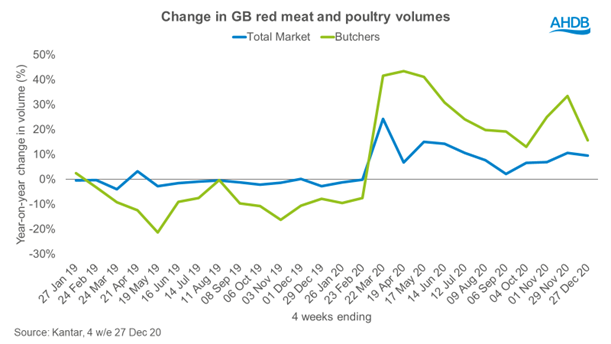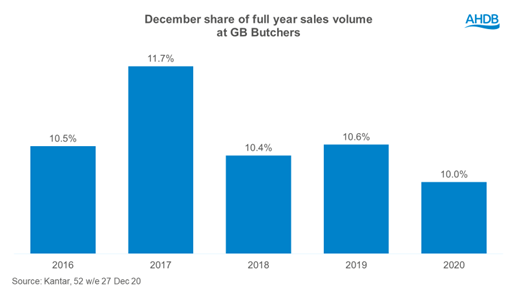Butchers outperform the market this Christmas
Tuesday, 2 February 2021
Butchers had their best Christmas in recent history, with shoppers buying 16% more red meat and poultry in December 2020 than they did in 2019 (Kantar, 4 w/e 27 Dec 20). This equated to an extra £8.5m spent at butchers over the four-week period.
This was driven by an increase in the amount shoppers purchased on each trip to the butchers, as gains in household penetration made throughout 2020 didn’t continue into December.
Comparing back to the rest of 2020
The December figures are certainly very positive and contributed to an overall increase in butchers’ sales of meat and poultry of +22% over the full year (Kantar, 52 w/e 27 Dec 20). This full-year uplift came from shoppers buying more product on each visit to the butcher, but also from an increase in shopper numbers. Throughout 2020, butchers’ shops had 550,000 more shoppers than they did in 2019.

However, significant uplifts at the start of the pandemic in spring 2020 meant that December still only accounted for 10% of volume sales – in line with typical levels seen in previous years. So whilst December represented the best Christmas ever, it didn’t increase importance of this month to the rest of the year.

Part of this is likely due to the rapidly changing restrictions surrounding Christmas. Following the government’s announcement on 19th December, shoppers had to change plans and, as a result, the biggest shopping day in December came on Monday 21st December, likely after butchers’ pre-order cut-off date. However, out of everything shoppers bought from butchers in the two weeks leading up to Christmas, 32% went out the door on Wednesday 23rd. Therefore, a future learning could be to publicise any availability, or increased flexibility, in the week leading up to Christmas.
How to keep shoppers throughout 2021
Butchers have outperformed the rest of the market in 2020. This is due to a variety of reasons, including avoidance of big stores as – at the height of the first lockdown back in April 2020, 49% of British shoppers said they were avoiding going into big supermarkets (AHDB/YouGov Consumer Tracker). Over time there has also been a growing desire to support local businesses; nearly two-thirds of shoppers who bought meat from a butcher last year said that supporting a local business was a key reason for doing so (AHDB/YouGov Consumer Tracker, Nov 20).
However, by November, the avoidance of big stores dropped back to 34%. So, with those initial concerns about the safety of supermarket already easing, the concern for butchers now is how to retain these new shoppers.
How new shoppers differ
Repeat shoppers are hugely important to butchers’ sales, accounting for 87% of spend at butchers in 2020. It’s therefore vital to keep these shoppers engaged through the high quality and expertise they desire, while appealing to new shoppers, who are those who hadn’t stepped foot in a butchers’ shop the year prior.
These new shoppers are more likely to be wealthier and younger shoppers. Therefore, there is a longer-term generational opportunity in engaging with these younger shoppers so that they carry this new use of butchers’ shops through to older age.
On each visit to the butcher, new shoppers will buy just as much volume of product than repeat shoppers, at around 2kg per trip. They just don’t visit a butchers as often as repeat shoppers, so finding ways to get them to visit more frequently is important - perhaps by having a new or promoted special each week, offering meal boxes/kits and engaging with them through social media.
When these new shoppers do visit the butcher, that 2kg basket is more likely to be made up of red meat than it is chicken. Roasting joints are the most popular option for new shoppers, but the cuts they’re more likely to look for, over repeat shoppers, are lamb chops, beef burgers and steaks.
While getting the range right will be important, it’s vital that quality is maintained, as this is a key reason for people choosing to shop at a butcher, and also how shoppers justify the higher average price per kilo. AHDB’s Quality Standard Mark (QSM) is underpinned by standards that look after welfare and food safety but also offers guaranteed eating quality. At present there are circa 2,100 high street and farm butchers within the scheme and take advantage of recipe and other materials provided by AHDB.
Related content
Topics:
Sectors:
Tags:

